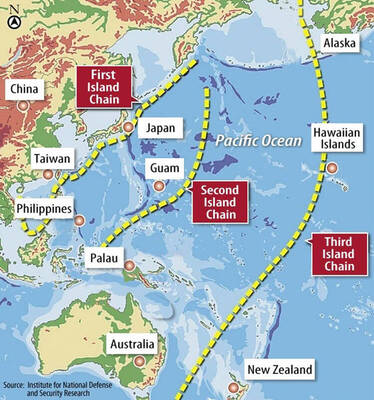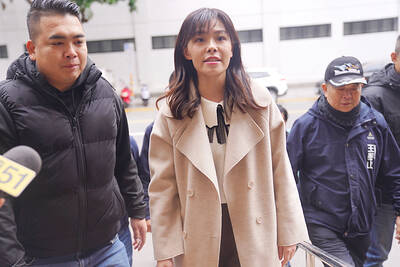Japan said yesterday it had placed under state control a lighthouse built by nationalists on a disputed island in the East China Sea despite rival claims by China and Taiwan.
The 5.6m lighthouse was erected in 1988 by Japanese right-wing activists to mark a claim on Uotsuri-jima, the largest of the Diaoyutai islets, known in Japan as the Senkaku islands, which lie between Taiwan and Japan.
"Those who built the lighthouse said they can no longer run it," Vice Foreign Minister Shuzen Tanigawa told a news conference.
"Since they have abandoned the right of possession, it has been transferred" to the state, Tanigawa said.
"Japan has been saying [the islands] are traditional Japanese territory," he said.
"Even if we have some trouble, we are going to protect what we have to protect," he said.
The move comes amid rising tensions between Japan and China, including a dispute over a major gas field near the islands where a Chinese nuclear submarine intruded in November, setting off a two-day chase.
Tokyo has already informed Beijing of the transfer of lighthouse authority, Tanigawa said, adding that it had yet to receive any reaction from the Chinese side.
Japan declared the oil-rich but uninhabited islands to be part of its territory in 1895, the same year it annexed Taiwan.
The tiny islands were under control of the US, which used them for military drills until 1972, when they were returned to Japan together with Okinawa.
In the early 1970s, China and Taiwan made claims to the islands after oil deposits were confirmed in the area by a UN agency.
Last March, Japanese authorities arrested and deported seven Chinese activists after they went to the islands, causing a diplomatic row with Beijing.
The activists were the first people to land on the disputed islands since 1996.
Relations between Japan and China have been increasingly strained in recent months, in part over disputes about the nearby gas field where Beijing began drilling in 2003, despite Tokyo's protests.
In December, Japan for the first time listed China as a potential threat in revised defense guidelines.
China, in turn, has been incensed over Japanese Prime Minister Junichiro Koizumi's repeated annual visits to the Yasukuni shrine, which honors Japanese war dead, including war criminals.
China has refused all bilateral state visits because of Koizumi's pilgrimages. The Japanese premier defends his visits, but has not gone to the shrine this year.
Taiwan's Ministry of Foreign Affairs spokesman, Michel Lu (
"The Japanese government's move to take control of the lighthouse is expected to create a calmer climate for future Taiwan-Japan negotiations," Lu said.
Lu insisted the Diaoyutai islets belong to the Republic of China.
"However, Taiwan's government will continue to hold talks with Japan to find a satisfactory solution to the dispute," Lu said.

The US government has signed defense cooperation agreements with Japan and the Philippines to boost the deterrence capabilities of countries in the first island chain, a report by the National Security Bureau (NSB) showed. The main countries on the first island chain include the two nations and Taiwan. The bureau is to present the report at a meeting of the legislature’s Foreign Affairs and National Defense Committee tomorrow. The US military has deployed Typhon missile systems to Japan’s Yamaguchi Prefecture and Zambales province in the Philippines during their joint military exercises. It has also installed NMESIS anti-ship systems in Japan’s Okinawa

‘WIN-WIN’: The Philippines, and central and eastern European countries are important potential drone cooperation partners, Minister of Foreign Affairs Lin Chia-lung said Minister of Foreign Affairs Lin Chia-lung (林佳龍) in an interview published yesterday confirmed that there are joint ventures between Taiwan and Poland in the drone industry. Lin made the remark in an exclusive interview with the Chinese-language Liberty Times (the Taipei Times’ sister paper). The government-backed Taiwan Excellence Drone International Business Opportunities Alliance and the Polish Chamber of Unmanned Systems on Wednesday last week signed a memorandum of understanding in Poland to develop a “non-China” supply chain for drones and work together on key technologies. Asked if Taiwan prioritized Poland among central and eastern European countries in drone collaboration, Lin

NO CONFIDENCE MOTION? The premier said that being toppled by the legislature for defending the Constitution would be a democratic badge of honor for him Premier Cho Jung-tai (卓榮泰) yesterday announced that the Cabinet would not countersign the amendments to the local revenue-sharing law passed by the Legislative Yuan last month. Cho said the decision not to countersign the amendments to the Act Governing the Allocation of Government Revenues and Expenditures (財政收支劃分法) was made in accordance with the Constitution. “The decision aims to safeguard our Constitution,” he said. The Constitution stipulates the president shall, in accordance with law, promulgate laws and issue mandates with the countersignature of the head of the Executive Yuan, or with the countersignatures of both the head of the Executive Yuan and ministers or

BACK TO WORK? Prosecutors said they are considering filing an appeal, while the Hsinchu City Government said it has applied for Ann Kao’s reinstatement as mayor The High Court yesterday found suspended Hsinchu mayor Ann Kao (高虹安) not guilty of embezzling assistant fees, reducing her sentence to six months in prison commutable to a fine from seven years and four months. The verdict acquitted Kao of the corruption charge, but found her guilty of causing a public official to commit document forgery. The High Prosecutors’ Office said it is reviewing the ruling and considering whether to file an appeal. The Taipei District Court in July last year sentenced Kao to seven years and four months in prison, along with a four-year deprivation of civil rights, for contravening the Anti-Corruption